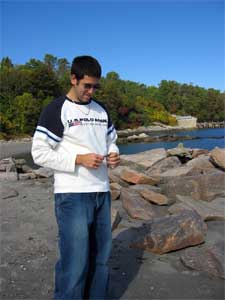 KINGSTON, R.I. — October 31, 2006 — University of Rhode Island sophomore Nick Larghi explored the coast of Rhode Island during the last six months to discover on what type of surface oysters grow best and to see if oyster restoration sites are producing young oysters, which are also called spat.
KINGSTON, R.I. — October 31, 2006 — University of Rhode Island sophomore Nick Larghi explored the coast of Rhode Island during the last six months to discover on what type of surface oysters grow best and to see if oyster restoration sites are producing young oysters, which are also called spat.
“The North Cape Shellfish Restoration Project has set up six restoration sites throughout Rhode Island over the last four years where they have seeded oysters that are now growing,” Larghi said, “I’ve set up experiments to test which surface oyster spat favored most and to see how many spat are settling.”
He used an artificial surface as a settlement plate and scattered clamshells throughout the sites because oysters favor hard surfaces. Then he checked the sites regularly and observed the shells under a microscope to examine whether any oysters had developed.
Larghi found that the oyster spat settled on his shells and artificial surfaces in tanks, but did not settle on the ones he had established in the ocean.
“Some just don’t survive,” explained the Wakefield resident. “There can be thousands of spat but only a few may survive. They may not have found my site or they may not have liked the surfaces that were provided. There is a lot of water considering the size of my experimental surfaces.”
Larghi’s research was conducted as part of the Coastal Fellows Program, a unique initiative designed to involve undergraduate students in addressing current environmental problems. Now in its eleventh year, it is based at URI’s College of the Environment and Life Sciences. Students are paired with a mentor and research staff to help them gain skills relevant to their major and future occupations.
Funding for the research was provided by the North Cape Shellfish Restoration Program, which is jointly administered by the National Oceanic and Atmospheric Administration, the Rhode Island Department of Environmental Management Marine Fisheries section and the U.S. Fish and Wildlife Service.
“Ever since I was a little kid, I loved the ocean,” Larghi said. On campus, Larghi has been involved in the URI Sailing Club and is a member of the Student Film Association where he and friends create films.
During his Coastal Fellows research, he explored other aspects of marine biology through his participation in other students’ research projects while also earning his scuba certifications.
Though his oyster research is over, Larghi hopes to conduct more underwater research. “It would be nice to maybe try deep water research next,” Larghi said.
Pictured above
URI student Nick Larghi of Wakefield examines an oyster at one of his
research sites in South County.

